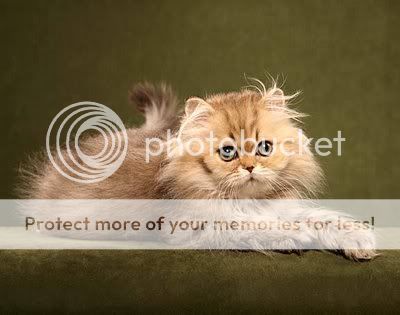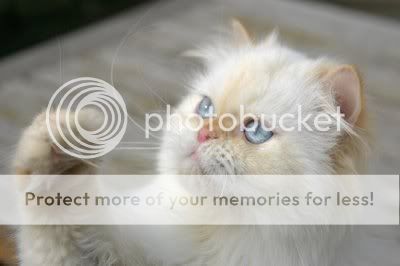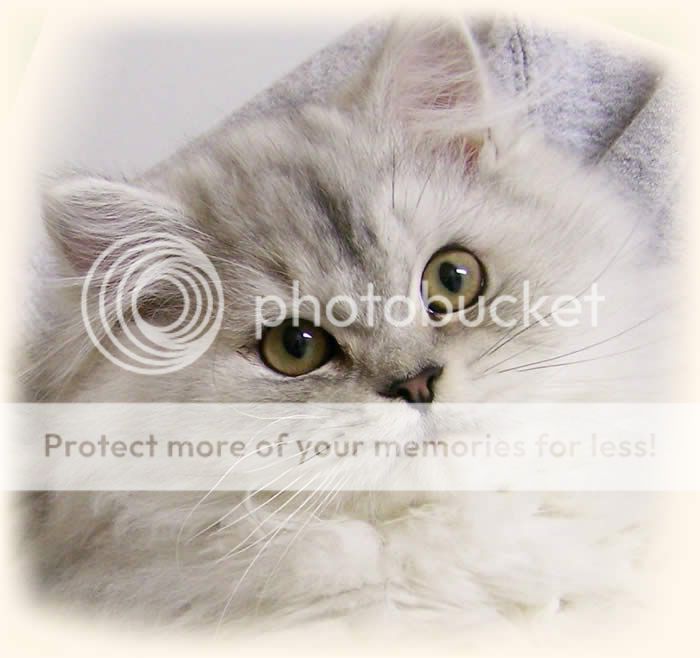
Lately, I have noticed that my male Persian cat has a problem with watery eyes. One of his eye starts to tear. There is a slight mucus like liquid that gathers around his eye.
A quick trip to the vet and I found out that this is one of the more common health issues that afflict the Persian cat.
I found the article below helpful in understanding issues that might affect my Persian cat. An informed pet owner is a good pet owner!
 Persian KittensPersian Cats - Health IssuesBy Frank Will
Persian KittensPersian Cats - Health IssuesBy Frank WillPersian Cats are by far and away the most popular breed, but there are some very common health problems and a few special nutritional needs required for this magnificent cat.
The breeding habits of some non reputable breeders have made several of these health problems more common in both the Ultra Persian and the Traditional Persian; however, it seems that these issues may be more prevalent with the Ultra breeds.
All health concerns and most problems will all start with the breeder. If you are very serious about getting this breed of cat, make absolutely sure you do as much background checking as you can on the breeder and get as many references as possible.
The Persian cat is perhaps the oldest breed of cat, dating back into the ancient days of Iran, when is what actually called Persia. This magnificent breed has a grace in the way they walk and majesty in their demeanor, but they are also quite lazy, which can lead to some health issues as such as obesity.
Because of their natural dense fur that can be up to 8 to 10 inches long in some cases, they are also slightly more prone to health issues.
But they are by no means unhealthy cats, but they do have some issues.
PDK: Polycystic Kidney Disease
The most common health issue in Persian Cats is referred to as PDK or polycystic kidney disease. This is an inherited disease and was first noticed in the late 1960's but there was not a lot of research on it until the 1990's.
This disease shows up between the ages of three years to ten years in Persians, and it will cause enlarged kidneys as well as kidney dysfunction. Cats that inherit this condition will be born with cysts and all of the problems develop when these cysts start to grow. As they grow and progressively enlarge, the kidney, because of this growth, is reduced in its ability to function properly.
The most serious of conditions will result in the failure of the kidneys and the death of your cat. The symptoms that your Persian has this condition will be a sudden lack of an appetite as well as an increased thirst and need to urinate.
There is currently no known treatment for this disease other than treatments similar to other forms of chronic kidney failure. Because it is only recently understood, there is still a lot of research to be done to devise effective treatments.
Tear Duct Overflow:
This condition can occur in any cat, but is more prevalent in Persians because of the flat features. These features may result in the failure of the tears to drain away properly. Compounding this issue is overproduction of tears which could be caused by infections, allergies, or some form of an irritant.
The natural form of a Persians face also makes drainage a problem due to wrinkling of the drainage ducts, abnormally small tear duct openings, and shallow tear lakes on the inner corners of their eyes. This is believed to be a chronic condition in Ultras because of breeding techniques.
The symptoms that you need to watch for will be a watery discharge in the eyes, tear staining below the eye, or ulcerations as well as obvious irritations to your pet on the skin below the eyes.
Effective treatments for tear duct overflow can include antibiotic ointments and it will be very important to keep the areas around the eyes clean to prevent infections. Trimming the hair beneath the eyes very carefully will also help the drainage. But be very careful.
There are some natural herbal ingredients such as Dandelion and German Chamomile that are natural eye cleaners and are very tonic in nature and quite soothing for your cat. In very serious cases, your cat may require surgery.
Chediak-Higashi Syndrome:
This condition is also one of the more common health concerns in Persians. It is an autosomal recessive genetic disorder that basically causes your pets hair to turn a smoky blue color. But what is especially dangerous about this condition is the development of nuclear cataracts that are associated with it. These infections can cause a prolonged bleeding in your cat.
Persians affected by this condition are also very prone to infections. There is no known treatment for this condition. Symptoms that you will have to watch for are muscle weakness, nerve problems in the legs, tremors, as well as numbness. In very severe cases there will be seizures, most likely followed by your cat passing, as it can be that serious.
Congenital Ankyloblepharon:
This condition is especially prevalent in Blue Persians. This is a situation where adhesion of the eyelids margin, or stick to each other. This is very common in both puppies and kittens, but very uncommon in adult cats. If this persists, it can result in swelling and infections as well as several serious eye conditions.
A warm, wet cotton ball will usually free the eyelids, but if not, immediate care may be needed.
Urinary Tract Stones:
All cats can have this condition, but it is much more prevalent in Persians. These are small stones that are found within the bladder, and in most cases they are passed with urine. If they puss up and are not passed, it becomes an emergency situation, as it blocks the urinary tract.
Symptoms will be abnormal urine patterns, as well as difficulty urinating or frequent urination. You will also need to watch for cloudy urine, or blood in the urine. These stones are made up primarily of magnesium, ammonium and phosphate.
A low magnesium diet will help to eliminate these stones in most cases.
Hip dysplasia and well as patellar luxation, a condition in which your cat's knee caps slides, are also known health conditions in Persian cats.
Summary:
These are all health concerns that you need to be aware of when selecting a Persian, but with the correct breeder most can be averted. These cats will also need some special treatments for there gorgeous hair coatings.
You should always look for hair supplements that have all of the B vitamins, as well as zinc and fatty acids to bring out the brilliance of their coats.
The cats are perhaps the most gentle and docile of all the cat breeds. It is recommended to keep them indoors to keep their fur free of parasites as well. Overall, they make wonderful and very affectionate companions, despite some health concerns.
I am an avid lover of pets and my wife and I have had several pets throughout our years. We are especially fond of dogs, and we have a 12 year old Dalmatian (our 3rd) and a "mutt" that we rescued when someone threw him away to die in a vacant field.
He found us, nearly starved to death, and weighed about 2 pounds.
After severe bouts of mange and severe dehydration, and over 1,000.00 in veterinarian bills, we saved the little guys life, and he is one of the best, if not the best, dogs we have ever had and today is a muscular, fit, and firm 70 pound best friend.
After finishing my MBA, which at middle age was not easy, I decided to keep the research work ethics that I acquired, and devote about two hours each night in understanding the health benefits of supplementation for both humans and pets and how they might strengthen our, as well as our pets, immune system in a pre-emptive approach to health rather than a reactionary approach.
Both of my daughters are avid cat lovers, and asked me to help them with health concerns and challenges with their cats.
I am not a veterinarian nor claim to be, just a lover of pets that loves to research and pass on some knowledge that might be helpful, or at least stimulating to the thought process.
Several of the articles that I have written can be found on my website;
Liquid Vitamins & Minerals for Humans & Pets
http://www.liquid-vitamins-minerals-humans-pets.com
Article Source: http://EzineArticles.com/?expert=Frank_WillPersian Cats Pictures

 Persian Cat
Persian Cat
What's Under that Table?
 Persian Cat Playing
Persian Cat Playing
Gimme That!

Persian Cat Information
Caring for Persian Cats
Persian Cat Behavior
Labels: Persian Cat Health, Persian Cats




































